Stainless Steel Bathtub Drain Assemblies Explained
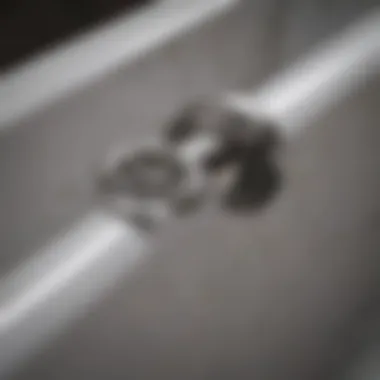
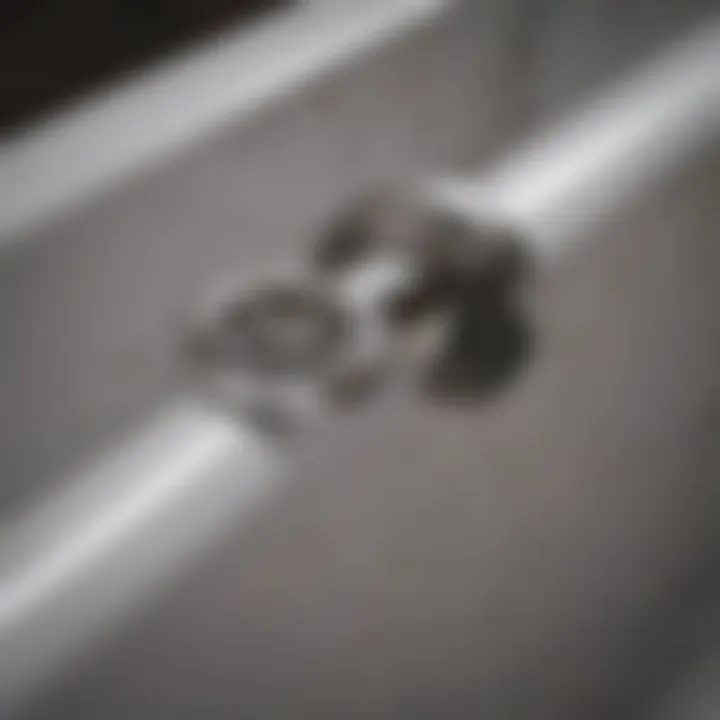
Intro
In the realm of home improvement, the significance of seemingly small details often gets overshadowed by major renovations. However, when it comes to bathroom design and functionality, elements like a stainless steel bathtub drain assembly play a crucial role in both aesthetics and utility. With the rise in popularity of stainless steel possessing not only strength but elegance, choosing the right drain assembly can significantly elevate a bathroom’s style while enhancing its performance.
This guide seeks to provide an extensive exploration of stainless steel bathtub drain assemblies. It discusses their intrinsic design, essential functions, and the manner in which they can be seamlessly integrated into various bathing spaces. Homeowners, DIY enthusiasts, and design aficionados alike will find a wealth of practical knowledge here—perfect for deciding which drain assembly enhances their bathing environment.
Design Inspirations
Right from modern minimalism to vintage glam, the design of a bathroom often reflects personal tastes and trends. Stainless steel bathtub drain assemblies can align effectively with various design preferences:
Latest Trends in Bath and Bedroom Design
As many homeowners move towards sleek and versatile designs, the push for open, fluid spaces within the bathroom has become more prevalent. Stainless steel drain assemblies, known for their clean lines and polished surfaces, easily adapt to various themes. They pair well with:
- Contemporary aesthetics: Minimalistic fixtures, glossy tiles, and monochrome palettes harmonize beautifully with stainless steel.
- Industrial themes: A more rugged or urban feel can be achieved by combining stainless steel with elements like exposed brick or concrete, creating a striking contrast.
- Rustic styles: When combined with wooden vanities and warm tones, stainless steel offers a modern touch to a traditional space.
Color Palettes and Themes
When selecting a bathtub drain assembly, it’s important to consider how it fits into your color scheme. Stainless steel complements a variety of hues:
- Neutrals: Whites, blacks, and grays can amplify the sleek appeal of stainless steel, creating a calm and serene atmosphere.
- Bright colors: A bold color scheme, when paired with stainless steel, can introduce exciting focal points without overwhelming the space.
- Earthy tones: Shades of brown, green, and beige can provide warmth and a touch of nature, where stainless steel adds a hint of sophistication.
As design continues evolving, understanding how components like bathtub drain assemblies fit into these themes becomes essential for any homeowner looking to revamp their space.
Functional Elements
Beyond aesthetics, the functionality of a bathtub drain assembly is its core identity. Proper installation and design can optimize the use of space within the bathroom, addressing the needs of busy households.
Space Optimization Tips
An efficient drainage system is crucial in avoiding water pool issues and promoting a tidy appearance. Some tips to consider:
- Choose the right size: Ensure that the drain assembly fits well with the bathtub’s dimensions and is capable of handling water flow effectively.
- Consider placement: Strategically placing the drain assembly can aid in preventing water accumulation, especially in smaller bathrooms.
- Incorporate storage solutions: Instead of bulky cabinets, opting for tighter, streamlined drainage units may free up valuable floor space.
Multi-Functional Furniture Choices
Selecting furnishings that work hand-in-hand with the drain assembly can be beneficial:
- Vanities with built-in storage: These can maximize space while allowing easy access to plumbing, reducing clutter around the tub.
- Floating shelves: They provide a modern look and keep essential items within easy reach, complementing the clean lines of the stainless steel.
- Compact bathtubs: Choosing models that integrate seamlessly with the drain can save space and maintain design coherence.
The interplay between design and functionality is where homeowners can truly create a space that meets both practical needs and aesthetic desires.
A conscious design approach considering both appearance and utility can elevate any bathroom, making the choice of a stainless steel bathtub drain assembly just one piece of a larger puzzle.
Preamble to Bathtub Drain Assemblies
Bathtub drain assemblies are one of those things that people often overlook until there's a problem. They sit quietly, doing their job behind the scenes, but their value in ensuring a smooth bathing experience really can’t be overstated. A proper drain assembly not only helps in getting rid of used water efficiently but also prevents potential leaks that could lead to extensive water damage and costly repairs.
In this guide, we dive into every nook and cranny of stainless steel bathtub drain assemblies. Homeowners, DIY enthusiasts, and design aficionados can uncover not just the mechanics behind these assemblies but also their crucial role in both functionality and aesthetics of your bathroom. The right drain assembly can keep the space tidy and, more importantly, dry.
Understanding the Role of Drain Assemblies
The integral function of drain assemblies lies in their design, which encompasses components that manage the water flow from the bathtub. Any drain assembly worth its salt should prevent water from backing up, ensuring that when you pull the plug, the water drains away fast and clean.
In addition to their primary function, the role of the drain assembly extends to aesthetic considerations. With the rise of various styles and materials, particularly the polished look of stainless steel, these assemblies also contribute to the overall feel of the bathroom. A well-designed assembly not only performs well but also complements the entire design scheme.
"A well-functioning drain is like the unsung hero of the bathroom—often unnoticed, but immensely vital."
Drain assemblies come into play also when it comes to maintenance. Regular checks and cleanings can prolong their lifespan and ensure a hassle-free experience. Homeowners should understand how to maintain their assemblies properly, allowing for preventive measures against common issues such as blockages and leaks.
In short, understanding the role of bathtub drain assemblies isn't just about plumbing basics—it's about appreciating how these components relate to the overall health and aesthetics of your bathing sanctuary. Knowledge here will empower you, enabling informed decisions that correlate design and function in your home.
The Case for Stainless Steel
When it comes to choosing the right material for a bathtub drain assembly, stainless steel stands out as a frontrunner for several good reasons. Its specific properties make it an excellent choice not only for practical use but also for enhancing the overall look of your bathroom. Considering various elements such as durability, corrosion resistance, and aesthetic appeal underlines the advantages of opting for stainless steel.
Advantages of Stainless Steel in Drain Assemblies
Durability
Durability is a key factor when selecting materials for any home improvement project. Stainless steel is specifically designed to endure the daily wear and tear of bathroom use. Unlike plastic or less robust metals, stainless steel doesn't warp or crack over time. This resistance to damage is essential, particularly in a humid environment such as a bathroom.
A prominent characteristic of stainless steel is its strength. With the ability to bear weight and resist impacts, this material is beneficial for drain assemblies that experience frequent pressure. A unique feature lies in its long lifespan, which can lead to lower replacement costs over time. Though it might have a higher initial price than other options, not having to replace it down the line can balance the scales in favor of stainless steel.
Corrosion Resistance
One of the foremost concerns in any plumbing system is the risk of corrosion, which often leads to leaks and failures. Stainless steel is known for its outstanding corrosion resistance, primarily due to its unique composition that includes chromium. This element creates a protective layer on the steel surface, hence preventing rust.
In terms of practicality, this corrosion resistance means that homeowners can maintain their bathtubs with ease. The occasional splash of water or soap doesn’t pose a significant threat. The reality is, this feature saves homeowners from frequent repairs and replacements, making it a popular choice in places where moisture is a factor.
Aesthetic Appeal
Let’s be honest, the bathroom is more than just a functional space; it should feel like a haven. Aesthetics play a pivotal role in creating that ambiance. Stainless steel shines with a modern look that complements a variety of decor styles, from minimalist to contemporary. This material not only looks sleek but also reflects light beautifully, enhancing the room's overall brightness.
Additionally, stainless steel's versatility allows for seamless integration with other fixtures and finishes. Including it in your bathtub drain assembly can elevate the bathroom's overall appearance. The unique feature of its polished texture does provide a touch of elegance that resonates well with both classic and modern designs.
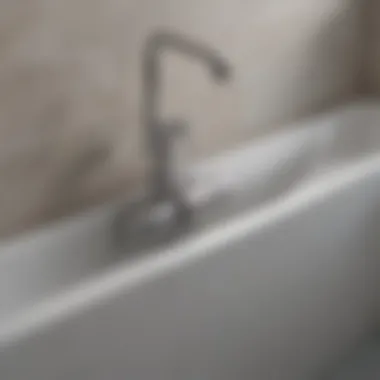
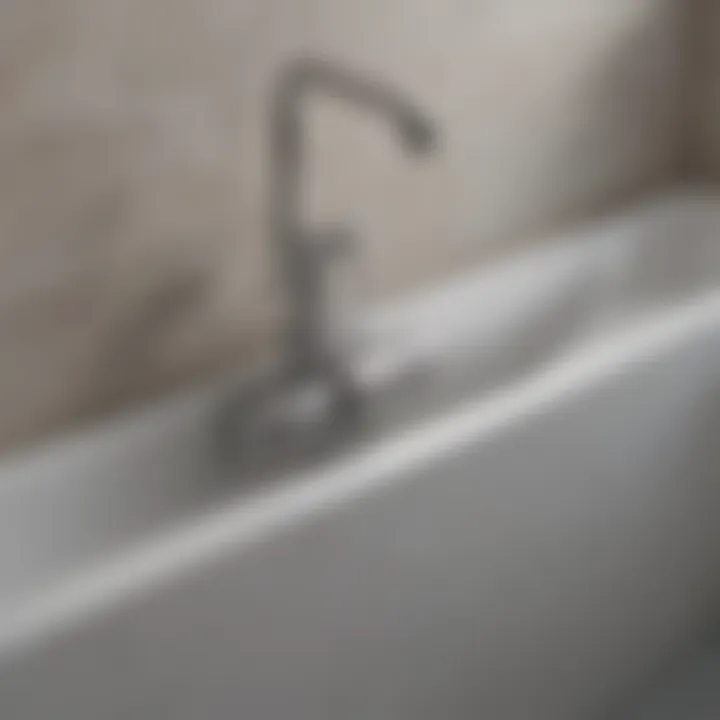
"Choosing stainless steel for drain assemblies not only brings durability and longevity but also contributes a contemporary elegance to bathrooms that every homeowner aspires for."
Overall, opting for stainless steel in bathtub drain assemblies is more than just functionality; it bridges the gap between style and practicality, ensuring a worthwhile investment for any homeowner.
Components of a Bathtub Drain Assembly
The components of a bathtub drain assembly are crucial to its functionality and longevity. Understanding these key parts helps homeowners make informed decisions regarding installation, replacement, and maintenance of their drains. Each element plays a significant role, workin together to ensure that water flows smoothly, without leaks or blockages and contributes to the overall bathing experience. By diving into the specifics of these parts, one can appreciate not only their design but also their practical applications.
Key Parts Explained
Drain Body
The drain body serves as the central hub of the entire assembly. It provides a direct channel for the water to exit the bathtub. One of the key characteristics of the drain body is its construction material, which often is stainless steel in high-quality assemblies. This choice offers both durability and resistance against corrosion. Notably, the unique feature of a stainless steel drain body is its strength, which stands up well against the wear and tear of everyday use. While there’s a higher initial cost involved, its long lifespan makes it a beneficial investment for any homeowner looking at a bathtub upgrade.
Strainer
Strainers play an integral part in a bathtub drain assembly. Their primary function is to catch debris—hair, soap scum, and other particles—that could potentially cause clogs. The key characteristic of a good strainer is its mesh size; a finer mesh catches more debris, preventing it from entering the plumbing system. On the downside, one unique feature of strainers is that they require regular cleaning. If ignored, they can become blocked, leading to poor drainage. However, a well-maintained strainer can significantly extend the life of the entire drainage system.
P-Trap
The P-trap is one of the most interesting components in any plumbing system. Its S-shaped design creates a water seal that prevents sewer gases from entering your bathroom. What makes the P-trap a beneficial choice is its ability to hold a small amount of water, which acts as a barrier to those unwanted odors. A potential disadvantage is that, over time, debris can accumulate in the trap, leading to blockages. Regular inspection and cleaning can mitigate this, making it a crucial part of a well-functioning bathtub drain assembly.
Tailpiece
The tailpiece connects the drain body to the trap, forming a critical link in the assembly. Often made of stainless steel or plastic, it’s straightforward in its design but essential for proper drainage. The key feature of a tailpiece is its length; it can be adjusted to fit various bathtub designs and depths. One advantage of a tailpiece is its flexibility in installations, though its quality can affect the overall durability of the assembly. A low-quality tailpiece may warp over time, causing leaks. Hence, choosing one made from robust material is always advisable.
"A small investment in quality components can lead to substantial savings in repairs and maintenance down the line."
By examining these crucial elements closely, homeowners can better appreciate their bathtub's drainage system. Each part matters, and understanding their roles will empower anyone when it comes to shower or bathtub renovations.
Types of Bathtub Drain Assemblies
When it comes to selecting the right bathtub drain assembly, understanding the various types available is crucial. Each design carries unique benefits and considerations that can affect functionality, ease of use, and indeed, the overall aesthetics of the bathroom. A thorough understanding helps homeowners make informed decisions, aligning the practical aspects with their design preferences.
Standard vs. Modern Drain Styles
The conversation around drain styles frequently starts with a distinction between standard and modern designs. Standard drain styles, often seen in older homes or more traditional setups, generally focus on functionality. These designs offer reliability but can sometimes lack visual flair. For instance, a standard pop-up drain is simple and effective; all you need to do is pull it to open or close the drainage.
On the other hand, modern drain styles aim to enhance both function and appearance. They often incorporate sleek lines, innovative materials like stainless steel, and can blend seamlessly into contemporary bathroom designs. They’re not just about draining water; they are elements of decor. A brushed nickel lift-and-turn drain, for example, can add a touch of sophistication while maintaining performance.
Comparison of Different Drain Mechanisms
When you dive into the specifics, the mechanisms of these drains play a significant role in user experience. Different drain types exist, each designed with a unique operating system along with its character traits that speak to the wants and needs of a homeowner.
Pop-Up Drains
Pop-up drains are quite commonplace and are favored for their simplicity. One notable characteristic is the easy operation mechanism, which involves a small lever or a pull that opens and closes the drain hole. This can be particularly advantageous in everyday use, allowing for quick adjustments without much fuss. However, a slight drawback might be their susceptibility to gunk buildup over time, which calls for regular cleaning to maintain functionality.
"Pop-up drains offer a hands-on experience that combines practicality with ease—perfect for any bathroom setup."
Lift-and-Turn Drains
Lift-and-turn drains are another popular choice. The key characteristic here is the twist action to engage or disengage the drain. This type is usually seen as a step up in terms of usability, as it requires just a simple twist to operate. They excel in functionality as they limit potential leaks due to the simplified components involved. However, similar to pop-up variants, they can demand maintenance over time, especially if the twist mechanism becomes stiff or the sealing mechanism starts to wear.
Toe-Touch Drains
Toe-touch drains, as the name suggests, are operated by simply tapping the drain with your foot, making them very convenient for those moments when you have your hands full. Their ability to be accessed without bending down is distinctive, and this reflects an evolution in bathroom design, catering to comfort and ease. The downside? Mechanisms can wear out quickly if used recklessly, necessitating periodic replacements or repairs.
Ultimately, choosing the right drain assembly isn't merely about functionality; it's about finding a balance that aligns with your lifestyle and aesthetic vision for your bathroom.
Installation of Stainless Steel Bathtub Drain Assemblies
When it comes to installing stainless steel bathtub drain assemblies, it’s not just a task for a skilled plumber but a valuable skill for any homeowner aiming to maintain control over their bathroom's functionality and aesthetics. The installation process plays a pivotal role in ensuring that all the components work seamlessly together, preventing leaks and ensuring long-lasting effectiveness. Engaging with the installation process not only boosts your home’s functionality but adds value to your property.
Preparation and Tools Needed
Before diving into the installation, preparatory steps are essential. Understanding what you need, both in terms of tools and materials, streamlines the actual installation process and minimizes headaches down the line. Common tools and materials you’ll need include:
- Adjustable wrench: Vital for tightening the fittings.
- Plumber's putty: Used for sealing connections.
- Screwdriver: Depending on your drain assembly, a flat-head or Phillips screwdriver may be required.
- Bucket: For catching any residual water during the removal process.
- Safety glasses: Protecting your eyes is crucial, especially when it comes to disassembling older fixtures.
Making sure you have all your ducks in a row before you start will set the stage for a smoother installation experience.
Step-by-Step Installation Process
Embarking on the installation journey requires a systematic approach. The process can be divided into three major steps, each with its specific nuances that contribute to the final outcome.
Removing the Old Drain
Removing the old drain can seem like a daunting task, but with proper method, it’s straightforward. The key aspect of this step is ensuring that you can access the drain without damaging surrounding fixtures.
- Turn off water flow: Before doing anything, shut off the water supply to the bathtub.
- Loosen the old assembly: Use an adjustable wrench to carefully unscrew the drain from the bathtub.
- Clean the area: Remove old plumber's putty or debris to ensure a proper seal with the new assembly.
This is a beneficial choice for anyone looking to upgrade or maintain their drain, allowing for a clean slate for the new installation. Another advantage is that you can closely inspect your plumbing, ensuring no hidden problems lurk beneath the surface.
Fitting the New Assembly
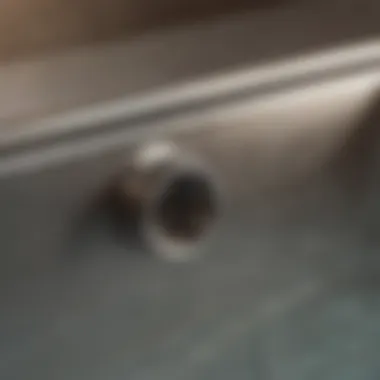
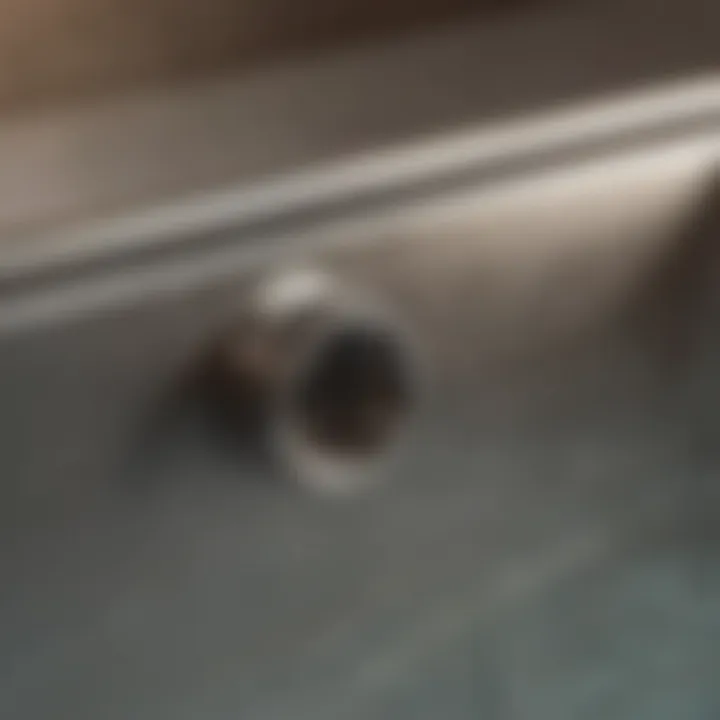
Fitting the new assembly requires careful consideration. Make sure you have the right size and type of drain for your bathtub model.
- Insert the new drain into the opening: Adjust until it fits snugly.
- Apply plumber's putty: Circle the base of the drain with the putty to help create a watertight seal.
- Tighten securely: Use your wrench to fasten the drain assembly while being cautious not to overtighten, which risks cracking the tub.
This step is integral as it determines not just the functionality of your new drain, but also its longevity. Proper fitting offers significant advantages, such as minimizing potential leaks and ensuring smooth operation.
Sealing and Testing
Sealing and testing comes last but is critical to finalize the installation. Making sure everything is watertight ensures you won’t face unexpected issues shortly after you've done all the work.
- Check seals: Inspect the connections and apply additional putty if necessary.
- Run water: Slowly turn the water back on and test for any leaks.
- Observe over a few minutes: Ensure there are no slow drips or damp spots.
This part of the process is vital, as a good seal can save you from future headaches. Plus, it gives you confidence in the install you’ve done, ensuring peace of mind.
"A well-installed drain is the cornerstone of a trouble-free bath experience."
Maintenance of Stainless Steel Drain Assemblies
Keeping your stainless steel drain assemblies in top shape is not just about keeping things looking good; it's also essential for proper function and longevity. The importance of maintenance cannot be overstated, as a well-maintained drain assembly helps prevent issues like clogs and leaks. Even though stainless steel is known for its resilience, neglect can lead to faster wear and additional problems that could incur unwanted costs down the line. By understanding and implementing straightforward maintenance practices, homeowners can significantly enhance the lifespan of their bathtub drains while ensuring optimal performance.
Regular Cleaning Practices
Recommended Cleaning Agents
When it comes to cleaning stainless steel drain assemblies, the choice of cleaning agents plays a crucial role. Household staples like vinegar and baking soda are often touted as effective and safe options. Vinegar, with its mild acidity, is great for dissolving soap scum and mineral deposits, while baking soda acts as a gentle abrasive that can help scrub away stubborn grime without scratching the surface.
Using these agents is a popular choice because they're not just effective; they're also eco-friendly. Another option is commercially available stainless steel cleaners that often contain surfactants and other ingredients designed to lift dirt while leaving a protective layer that helps prevent future buildup. While they can be effective, care should be taken to choose non-toxic products to ensure safety for household members.
The unique feature of using natural cleaning agents is that they’re gentle on both the environment and your health. However, it's worth noting that some homeowners prefer heavy-duty cleaners when facing particularly stubborn clogs or stains. This can lead to issues if those cleaners aren't thoroughly rinsed away, leaving residues that could dull the finish over time.
Cleaning Frequency
How often one cleans the drain assemblies can determine their longevity. Regular maintenance is key. Ideally, a quick clean every two weeks, followed by a deeper clean every month, can help keep your drain looking fresh and functioning well. For homes with hard water or high levels of soap usage, more frequent cleaning may be necessary to combat buildup.
Adhering to a consistent cleaning schedule not only maintains appearance but also prevents smaller problems from becoming bigger headaches. By regularly addressing potential issues, you’ll save yourself time and money in repairs. It's a beneficial practice because it ensures the drain assemblies remain free of blockages that can cause unpleasant odors or overflow problems.
"An ounce of prevention is worth a pound of cure."
By incorporating these cleaning practices, along with the right cleaning agents and a sensible cleaning schedule, homeowners can maintain their stainless steel drain assemblies effectively, ensuring they remain both functional and aesthetically pleasing.
Troubleshooting Common Drain Issues
When it comes to bathtub drain assemblies, knowing how to troubleshoot common issues can save homeowners both time and money. Issues can pop up like weeds in a garden, often leading to greater complications if not addressed promptly. This section aims to equip you with the knowledge needed to tackle problems effectively, ensuring smooth bathroom operations. It highlights practical methods to identify and solve problems, ensuring that your luxurious bath time remains uninterrupted.
Identifying Blockages
Blockages are the bane of any homeowner’s existence. They can stem from hair, soap scum, or even larger items that foolishly made their way down the drain. Knowing the signs of a blockage is key.
One of the first indicators is slow drainage. If you notice that water is taking its sweet time disappearing, that could be a warning sign.
A few common signs to look out for include:
- Gurgling Sounds: Unpleasant noises often suggest air trapped in the pipes.
- Water Backups: If water starts rising instead of flowing down, there�’s likely a clog up ahead.
- Bad Odors: A persistent smell can hint at stagnant water, pinpointing a blockage somewhere in the system.
To tackle the problem, you can start with a simple visual inspection, peering beneath the strainer to see if any obvious debris is present. An auger can be your best ally for stubborn clogs, as it can reach further down to clear blockages without damaging the pipes. In case traditional methods seem futile, it's best to contact a professional plumber who specializes in drain assemblies to avoid escalating the situation.
Resolving Leaks
Leaky drains can be a real headache. Not only do they cause water wastage, but they can also lead to structural damage if left unattended. Knowing how to address leaks is essential for maintaining both aesthetics and functionality in your bathing area.
First off, recognizing the source of the leak is crucial. Leaks can occur for several reasons:
- Worn Out Seals: O-rings or gaskets that have lived their time can become brittle.
- Loose Connections: If fittings or joints aren’t tightened well, you can bet on it, water will find its way out.
- Cracked Pipes: While less common, cracks can occur, leading to drips or even a steady stream, depending on the severity.
To solve leaks:
- Tighten Connections: Start by ensuring all connections are snug but not overly tightened to risk damaging the material.
- Replace Seals: If you suspect compromised seals, replace them with new ones to restore a good water-tight fit.
- Use Pipe Sealant: For threaded connections, applying some pipe sealant can help prevent future leaks.
"Properly maintaining your bathtub drain can extend its lifespan and reduce costly repairs in the future."
With regular inspections and prompt action, you can ensure that your stainless steel bathtub drain assembly continues to function as intended, thus preserving the serenity of your bathing experience. Understanding how to identify and resolve these issues not only enhances the longevity of your bathroom fixtures but also offers peace of mind.
Incorporating Drain Assemblies into Bathroom Design
When it comes to bathroom design, every element matters, and drain assemblies are no exception. While they often reside out of sight, cleverly hidden within the framework of the bathtub, their contribution to both the functionality and overall appeal of the space is paramount. Discussing the specifics of incorporating drain assemblies into your bathroom design isn't merely an exercise in aesthetics; it reflects an understanding of how these components play a critical role in enhancing the user experience.
There's a common notion among homeowners that plumbing fixtures should blend seamlessly with the rest of the decor. Concealed drain assemblies trim down visual clutter, leading to a clean, modern look. Homeowners can decide to showcase their drain assemblies as a statement piece, using stylish designs that harmonize with contemporary trends. This fusion of aesthetics and practicality can reveal a bathroom that's not just functional but also visually pleasing.
Several factors should be taken into consideration when merging functionality with design in this space. Durability, ease of maintenance, and visual coherence all come into play. For instance, a stainless steel drain assembly is not only resilient but can be finished in various styles, catering to different decor themes—be it rustic, minimalist, or anything in-between. Many designers opt for elements that can withstand time while requiring minimal upkeep.
Aligning Aesthetics with Functionality
To truly align aesthetics with functionality, designers and homeowners alike need to embrace the concept of harmony in design. Here, the focus is on selecting drain assemblies that not only serve their purpose effectively but also complement the materials and colors in the bathroom.
One of the pivotal aspects of this alignment is ensuring that the design complements the overall theme of the bathroom. If you're going for a sleek, modern look, a drain that boasts sharp lines and a polished surface will resonate well with that aesthetic. Meanwhile, if your bathroom incorporates more textured elements—like rustic wood or earthy tones—a more matte finish might better suit the spatial context.
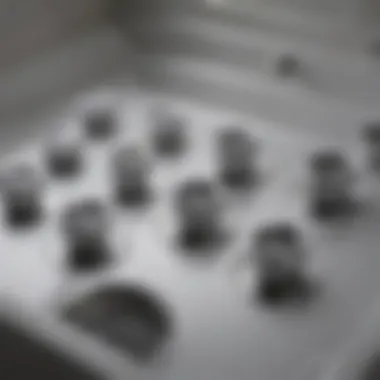
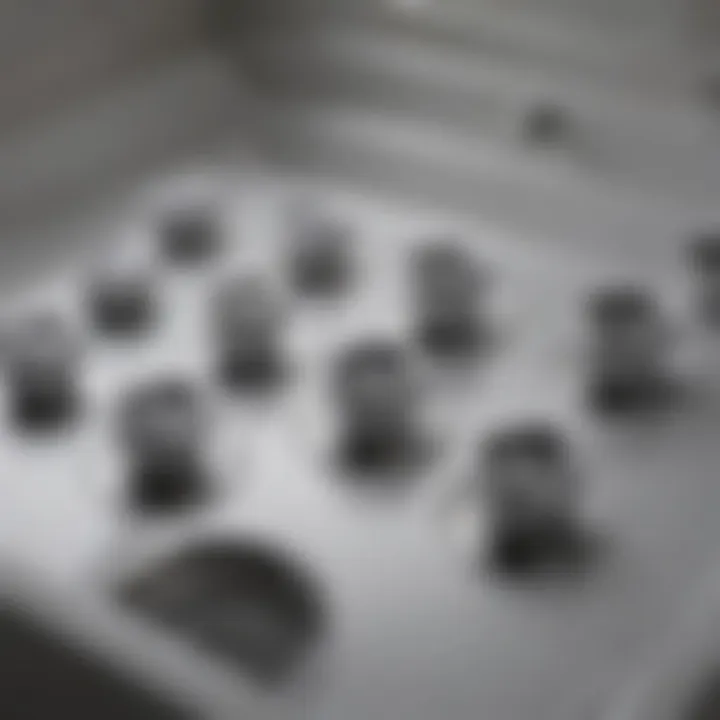
Ensuring that the drain assembly fits within the bathroom’s design narrative involves:
- Utilizing color schemes that echo throughout other fixtures like faucets and showerheads.
- Choosing shapes and styles that correspond to the overall design theme—be it round, rectangular, or bespoke custom pieces.
- Prioritizing positioning to enhance the effortless flow of water while ensuring it does not detract from the visual appeal of the other decor aspects.
"The true beauty of a bathroom's design lies not just in the grand elements but in the details that work seamlessly together."
Another critical consideration is maintainability. Drain assemblies constructed from stainless steel tend to resist corrosion, extending their longevity while keeping maintenance at a minimum. Regular upkeep should involve simple cleaning agents that are non-abrasive, ensuring the drain remains in top condition over the years. This simple step facilitates the harmonious blend of style and practicality.
Ultimately, investing in the right drain assembly contributes to the durability and aesthetic value of your bathroom. Homeowners can revel in the knowledge that they’ve not only made a beauty choice but also an intelligent one that enriches their living space for years to come.
Cost Considerations
When diving into any home improvement project, especially one involving water fixtures like a bathtub drain assembly, cost considerations can’t be shoved to the back burner. It’s essential to look into what you’re investing in, not just in terms of upfront prices but also in relation to long-term value. This leads to informed decisions that can save you headaches down the line.
Price Range of Stainless Steel Assemblies
The price of stainless steel bathtub drain assemblies generally varies based on several factors, including brand, design complexity, and additional features. Generally speaking, homeowners can find options ranging from $50 to $200 or more. Here’s how the costs might break down:
- Basic Models: These typically range from $50 to $80. They cover the basics without many frills. Ideal for someone looking for a straightforward replacement.
- Mid-Range Options: Priced between $80 and $150, these often come with improved aesthetic features and enhanced durability. They might be more suitable for an updated bathroom where looks and sturdiness matter.
- High-End Assemblies: For $150 and above, you’re looking at premium craftsmanship. Some designs boast features like noise reduction, faster drainage, and additional warranty protection.
Noteworthy to mention is that while it could be tempting to skimp on costs, remember that a cheaper assembly could lead to recurring repair bills that essentially wipe out your initial savings.
Long-Term Investment Benefits
Investing in a high-quality stainless steel bathtub drain assembly may feel like a pinch in your wallet initially, but it’s crucial to look at the bigger picture. Here are some long-term benefits:
- Durability: Stainless steel is known to withstand the test of time. It doesn’t rust or corrode as easily as other materials. This means that once installed, a stainless steel assembly can serve reliably for years, requiring little maintenance.
- Lower Maintenance Costs: Since they rarely require replacement, you'll save money on future repairs. Plus, the ease of cleaning stainless steel means you spend less on cleaning supplies over time.
- Value Addition: A well-maintained, elegant drain assembly can positively affect your home's resale value. Prospective buyers often pay more for homes that are equipped with quality fixtures.
- Aesthetic Appeal: A sleek stainless steel drain can elevate the bathroom's overall look, making it warmer and more inviting. Often, a beautifully designed drain assembly can complement other bathroom elements, which may ultimately lead to better pricing when it's time to sell.
"In the world of home improvement, sometimes spending a little more upfront can prevent big expenses down the line."
When weighing these points, it becomes clearer that the initial investment in stainless steel bathtub drain assemblies isn’t just about cost—it’s about value, longevity, and peace of mind. A little foresight goes a long way.
Sustainability and Eco-Friendliness
Creating a sustainable bathroom space is not merely a trend; it's becoming an essential aspect of responsible homeownership. As people aim to reduce their environmental footprint, the choices made in fixtures and materials can have a significant impact. Stainless steel bathtub drain assemblies stand out as a keen choice within this context.
Stainless steel contributes to a more sustainable living environment for several reasons. First and foremost, its longevity means it doesn’t need to be replaced often. This durability prevents the frequent disposal of materials, which in turn reduces waste. You might say it’s like getting a Cadillac out of your bathroom plumbing—built to last and tough as nails!
Additionally, when it comes to recycling, stainless steel takes the gold star. Roughly 60% of stainless steel components are comprised of recycled material. So, installing a stainless steel drain assembly is not just a nod to style but also aligns with eco-friendly practices that favor materials with high recirculation rates.
Another angle worth considering is its contribution to energy efficiency. Durable materials require less energy in production and transport. With less energy spent, homes can experience a decrease in overall energy bills. When you think of it that way, selecting the right drain assembly is more than an aesthetic choice; it’s a smart financial and environmental decision too.
"Investing in stainless steel products is not just an improvement to your home; it's a long-term commitment to sustainable living."
In comparison to plastic options, stainless steel presents a minimal risk of leaching harmful chemicals into the water system. Many homeowners overlook this aspect, but being conscious of what materials are entering their homes is critical.
Focusing on maintenance, stainless steel’s inherent resistance to corrosion means less money spent on harsh chemicals for upkeep. Regular cleaning is a breeze with natural techniques such as vinegar and baking soda, contributing again to the eco-friendly approach.
The Environmental Impact of Stainless Steel
Utilizing stainless steel in bathtub drain assemblies carries with it numerous environmental benefits. Here’s a closer look:
- Longevity: As mentioned, these drain assemblies are built to last, reducing the need for replacements.
- Recyclability: Stainless steel is one of the most recyclable materials available today, making it a smart choice for the environmentally aware homeowner.
- Energy-efficient Production: The production process for stainless steel can often be more energy efficient than that of plastic counterparts.
- Health Considerations: Safer materials mean a healthier living space, as they reduce the risk of harmful substances leaching into your water.
- Low Maintenance: Easy to clean with eco-friendly solutions, promoting a more sustainable cleaning routine.
To sum it up, opting for stainless steel not only enhances the functionality and aesthetics of your bathroom but also aligns your home with sustainable living principles. It's not just about making a wise purchase; it's about making a choice that impacts future generations in a positive way.
Future Trends in Drain Assembly Design
As we plunge deeper into the world of bathroom aesthetics and functionality, one of the most talked-about topics is the future trends in drain assembly design. This is not just a matter of where water goes, but also how design shapes our bathing experiences. In today’s cluttered market, understanding these trends can provide homeowners with a clearer path to achieving a blend of style and practicality.
Innovations in Materials and Functionality
The drive towards innovation in materials opens new doors for enhancing functionality. Stainless steel, having already carved its niche due to durability and corrosion resistance, is now evolving further. Designers and manufacturers are starting to explore alloys and composites that leverage the strengths of stainless while addressing its weaknesses. For example, new finishes or treatments could make stainless surfaces even more resistant to scratches and tarnishing, ensuring they stay looking fresh long-term.
Increasing attention is being directed towards sustainable materials. As eco-friendliness becomes a higher priority for designers and consumers alike, materials that are both recyclable and functional are gaining traction. These advancements mean that homeowners can select drain assemblies that not only perform well but also align with their values regarding sustainability.
In terms of functionality, we’re seeing smarter drainage solutions integrated into new designs. Digital technology in the shape of smart sensors and automatic mechanisms is becoming commonplace. Imagine a drain assembly that can self-clean or alert you of potential blockages via an app. It’s quite the leap from traditional systems, and while this might sound futuristic, some manufacturers are already prototyping these features.
"The future of drain assemblies isn't just about where the water goes—it's about enhancing the entire bathing experience through innovative design."
A growing trend focused on aesthetic appeal can’t be ignored either. Customization options are increasing, allowing homeowners to choose drain styles, shapes, and finishes that perfectly fit their design schemes. This means no more cookie-cutter drains; instead, every component can be uniquely tailored, promoting a cohesive design narrative throughout the bathroom space.
Key Considerations for Future Trends
- Cost and Value: While innovative materials and technologies come with their perks, it's also important to consider the cost involved. Designers and homeowners alike must weigh the benefits against potential price hikes.
- Long-term Maintenance: New doesn’t always mean better if it complicates upkeep. Future designs should keep maintainability in mind, ensuring that with all the new features, users are not left with more headaches than help.
- Compatibility: As the market evolves, ensuring that new drain assemblies remain compatible with existing plumbing systems is non-negotiable. A cutting-edge design should seamlessly fit into the existing infrastructure without necessitating extensive renovations.
The trends in drain assembly design are not just reshaping how we approach the basics of plumbing. Instead, they are redefining the user experience in bathrooms. Whether opting for smart technologies or eco-friendly materials, future homeowners have exciting options on the horizon. Keeping an eye on these developments could translate to a bathroom that is not only functional but also a real aesthetic showpiece.
The End
In wrapping up our detailed look at stainless steel bathtub drain assemblies, it becomes clear that these components play a critical role in both the functionality and aesthetic appeal of your bathing area. An effective drain assembly ensures not just proper water flow, but also contributes to the overall elegance of the bathroom.
Several key points stand out from our exploration:
- Durability: Stainless steel is resistant to rust and tarnish, making it a long-lasting choice in wet environments where traditional materials may falter.
- Maintenance: With straightforward cleaning processes, stainless steel drains can remain in top condition for years, enhancing their practicality.
- Design Versatility: From modern sleek lines to classic designs, these assemblies provide ample options to suit any bathroom style.
"A well-designed drain assembly not only ensures utility but also enhances the overall vibe of your sanctuary."
Installing a stainless steel bathtub drain brings long-term investment benefits, yielding a beautiful, functional space that stands the test of time. Additionally, considering sustainability in material choices means the future of your bath setup aligns with eco-friendly practices.
Reflecting on this guide, it becomes evident that making informed choices about your bathtub drain assembly is not just about function, but also about enhancing the aesthetics and longevity of your home. Taking these insights into account can certainly lead to a bathroom that is both practical and a joy to be in.















